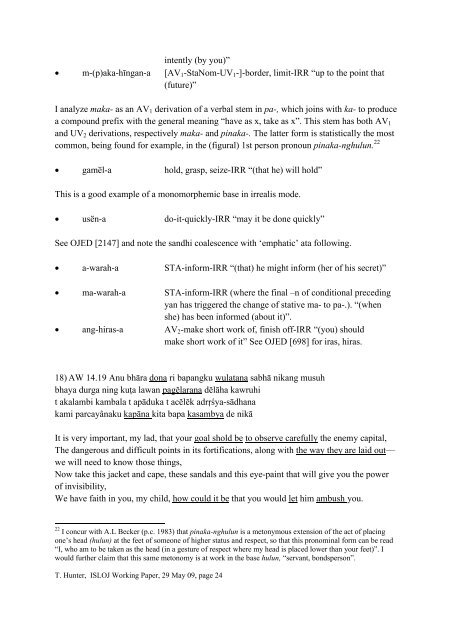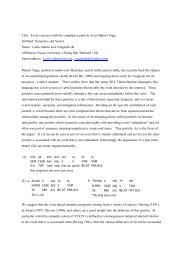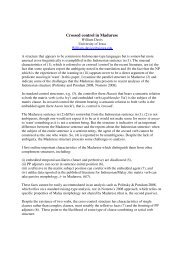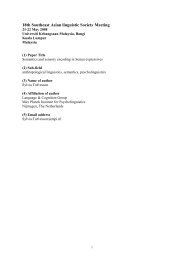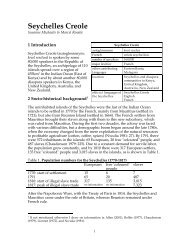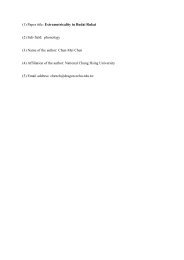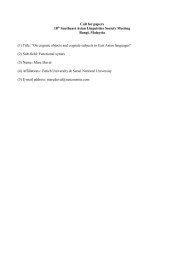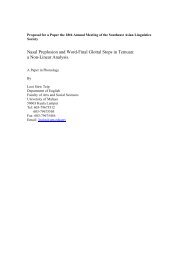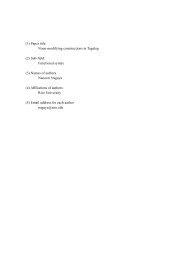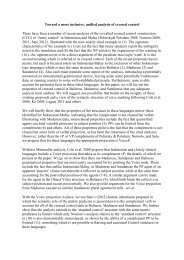Working Paper on Irrealis, Imperative Mode and Complementation ...
Working Paper on Irrealis, Imperative Mode and Complementation ...
Working Paper on Irrealis, Imperative Mode and Complementation ...
You also want an ePaper? Increase the reach of your titles
YUMPU automatically turns print PDFs into web optimized ePapers that Google loves.
intently (by you)”<br />
m-(p)aka-hīngan-a [AV1-StaNom-UV1-]-border, limit-IRR “up to the point that<br />
(future)”<br />
I analyze maka- as an AV1 derivati<strong>on</strong> of a verbal stem in pa-, which joins with ka- to produce<br />
a compound prefix with the general meaning “have as x, take as x”. This stem has both AV1<br />
<strong>and</strong> UV2 derivati<strong>on</strong>s, respectively maka- <strong>and</strong> pinaka-. The latter form is statistically the most<br />
comm<strong>on</strong>, being found for example, in the (figural) 1st pers<strong>on</strong> pr<strong>on</strong>oun pinaka-nghulun. 22<br />
gamӗl-a hold, grasp, seize-IRR “(that he) will hold”<br />
This is a good example of a m<strong>on</strong>omorphemic base in irrealis mode.<br />
usӗn-a do-it-quickly-IRR “may it be d<strong>on</strong>e quickly”<br />
See OJED [2147] <strong>and</strong> note the s<strong>and</strong>hi coalescence with ‘emphatic’ ata following.<br />
a-warah-a STA-inform-IRR “(that) he might inform (her of his secret)”<br />
ma-warah-a STA-inform-IRR (where the final –n of c<strong>on</strong>diti<strong>on</strong>al preceding<br />
yan has triggered the change of stative ma- to pa-.). “(when<br />
she) has been informed (about it)”.<br />
ang-hiras-a AV2-make short work of, finish off-IRR “(you) should<br />
make short work of it” See OJED [698] for iras, hiras.<br />
18) AW 14.19 Anu bhāra d<strong>on</strong>a ri bapangku wulatana sabhā nikang musuh<br />
bhaya durga ning kuṭa lawan pagĕlarana dĕlāha kawruhi<br />
t akalambi kambala t apāduka t acĕlĕk adrṛśya-sādhana<br />
kami parcayânaku kapāna kita bapa kasambya de nikā<br />
It is very important, my lad, that your goal shold be to observe carefully the enemy capital,<br />
The dangerous <strong>and</strong> difficult points in its fortificati<strong>on</strong>s, al<strong>on</strong>g with the way they are laid out—<br />
we will need to know those things,<br />
Now take this jacket <strong>and</strong> cape, these s<strong>and</strong>als <strong>and</strong> this eye-paint that will give you the power<br />
of invisibility,<br />
We have faith in you, my child, how could it be that you would let him ambush you.<br />
22 I c<strong>on</strong>cur with A.L Becker (p.c. 1983) that pinaka-nghulun is a met<strong>on</strong>ymous extensi<strong>on</strong> of the act of placing<br />
<strong>on</strong>e’s head (hulun) at the feet of some<strong>on</strong>e of higher status <strong>and</strong> respect, so that this pr<strong>on</strong>ominal form can be read<br />
“I, who am to be taken as the head (in a gesture of respect where my head is placed lower than your feet)”. I<br />
would further claim that this same met<strong>on</strong>omy is at work in the base hulun, “servant, b<strong>on</strong>dspers<strong>on</strong>”.<br />
T. Hunter, ISLOJ <str<strong>on</strong>g>Working</str<strong>on</strong>g> <str<strong>on</strong>g>Paper</str<strong>on</strong>g>, 29 May 09, page 24


